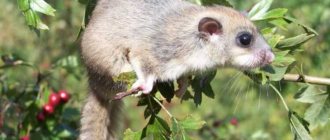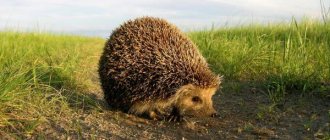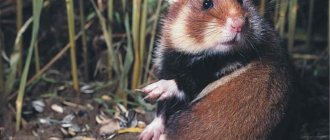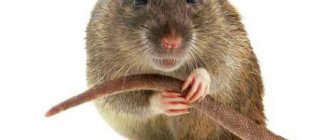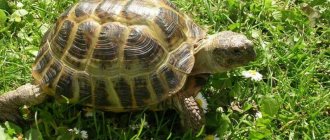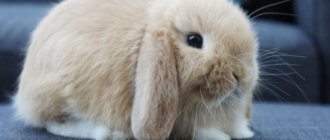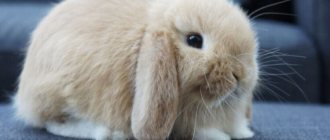Review author: “ZooVita”
At first glance, this mysterious animal from the order of rodents evokes tenderness and keen interest. These furry animals are so small that they fit completely into the palm of an adult. You can recognize a dormouse by its long and fluffy tail, as well as by its specific fur color.
Photos of forest dormouse can be found on the pages of reference books of fauna and wildlife representatives.
general characteristics
These rodents look like a field mouse or even a squirrel (the fluffy tail is especially similar).
The maximum size that a dormouse can reach is about 30 cm including its tail. Moreover, the tail is much longer than the body of the forest animal itself. The weight of the dormouse does not exceed 35-40 grams.
Description and distinctive features of the forest dormouse:
- Elongated muzzle shape.
- The presence of vibrissae - thin whiskers located on the muzzle. The long tactile fibers have a powerful muscle base, allowing the sleepyhead to explore its environment.
- The rodent's eyes are large relative to the body, allowing the dormouse to navigate in the twilight.
- The hind legs are significantly larger than the front ones, which determines the nature of the animal’s movement. Flexible front fingers allow the dormouse to freely climb trees and climbing vines, firmly clinging to protruding parts with the phalanges of its fingers.
- Many external signs can change depending on the nature of the forest animal’s diet and lifestyle. Owners of pet dormouse who provide proper care for their pet should remember this fact. A healthy rodent has shiny fur and an active, peaceful character.
You should know that the tail serves not only as an adornment for a forest dweller, but is also an organ of balance. The fur and coloring of the tip of the tail can signal the mood of its owner.
Reddened skin and fluffy fur indicate fear or aggression of the animal. This amazing fact is associated with the peculiarities of the structure and blood supply of the caudal region.
Large rodents
Chinchilla
Chinchilla (lat. Chinchilla) belongs to the order Rodents, suborder Porcupines, superfamily Chinchilla-shaped, family Chinchillaidae, genus Chinchilla.
Chinchillas have a round head and a short neck. The body is covered with thick soft hair, and hard hairs grow on the tail. The body length is 22-38 cm, and the tail grows 10-17 cm long. The weight of a chinchilla reaches 700-800 grams, while females are larger and heavier than males.
At night, chinchillas can easily navigate thanks to their huge eyes, which have vertical pupils. The whiskers of mammals grow up to 10 centimeters in length. Chinchilla ears are round in shape and have a length of 5-6 cm. In the ears there is a special membrane with which the chinchilla closes its ears when taking a sand bath.
The chinchilla's skeleton can be compressed in a vertical plane, so the animals can crawl into the smallest crevices. The hind legs of chinchillas are four-toed, and the front legs have 5 toes. The hind limbs are very strong and twice as long as the front ones, which allows mammals to jump high.
The life expectancy of a chinchilla reaches 20 years.
A couple of centuries ago, chinchillas were on the verge of extinction - they were destroyed because of their very valuable fur, but gradually the situation changed for the better for the animal and from the status of a hunting trophy, this rodent migrated into our homes to the status of a pet and everyone's favorite.
But in order for the animal to feel comfortable, healthy and cheerful, it is worth knowing how to properly feed it, what to feed it and is it possible to breed it at home?
Jerzy
The common hedgehog is a very famous mammal, widespread throughout Europe and even on some islands. Its appearance and lifestyle sometimes attract animal lovers who keep a hedgehog as a pet.
It is difficult to confuse a hedgehog with someone else: the entire back of the animal is densely covered with sharp short needles of black-gray color, the length of which is usually 2.5-3 centimeters. The needles stick out in different directions to cause maximum damage to enemies and provide a high degree of protection. The hedgehog's total body length ranges from 20 to 30 centimeters, and it also has a short tail - about 2-3 centimeters.
The weight of an adult animal varies from 600 grams to 1 kg; on the head of the hedgehog there is a long, wet black nose extended forward. It has sharp teeth, the number of which is greater on the upper jaw than on the lower jaw - 20 and 16, respectively.
The hedgehog has four short legs, each with 5 toes and claws. The front legs are 1.5-4 cm shorter than the hind legs. This animal has dense gray fur growing on its belly and between its spines. The needles themselves grow at the speed of wool, have a hollow structure inside and grow in numbers from 4 to 6 thousand pieces.
Rabbits
The decorative rabbit is a very cute creature. First of all, when getting this furry pet, you need to remember that this is not just a beautiful soft toy, but a living creature that needs constant care and attention.
Decorative dwarf rabbits are very cute and funny animals that love communication and attention. Those who got such a pet are convinced that communicating with him brings a lot of joy and good emotions. Caring for dwarf rabbits is easy and more cost effective than caring for a dog or cat.
Rabbits love to walk on grass on lawns, so be sure to purchase a collar and leash. Walking does not need to be done every day; the rabbit masters the tray perfectly and is not capricious. This pet is light and compact, so you can take it with you in a cage to the country house or on other trips. Even a child can carry the cage. But remember that this animal is very sociable and can become stressed from inattention. If it is necessary to leave, the animal can be entrusted to relatives or friends, as it easily tolerates a change of habitat.
Hares
To the surprise of many skeptics, hares are increasingly gaining a place next to people in their homes. With an average lifespan of 5 to 15 years, hares are very sociable, active and cute creatures. It's impossible not to get attached to the big-eared cutie.
There are various reasons why hares have evolved from being a simple source of meat to being one of the best pets in recent years. Here are some of them:
- They are very sociable creatures that do not require any special training;
- They are very playful and funny;
- Being very sociable creatures, they need constant interaction with people and other hares;
- They are willing to play with people and other animals outside of their cage every day.
If you want to have a bunny, then you should know that a lot of work will await you. Along with the arrival of a pet into your home, you have a huge responsibility for it.
Marmots
The marmot is a mammal. Belongs to the order of rodents from the squirrel family. The most common steppe species is also called boibak.
In nature, it lives in the steppe and forest-steppe areas, but also takes root well in captivity. Requires increased attention, but quickly becomes attached to its owners. It is considered the most intelligent of the group of rodents that have adapted to home conditions. Each marmot has a special character and temperament.
Marmots are most often small in size. But among rodents, this is one of the largest species; an adult is about the size of a cat. They can weigh from 5 to 10 kg, with a height of 40 to 50 cm. They wear a fluffy fur coat of a sandy or brownish-reddish hue. They are born without hair and blind, first feed on their mother's milk, then switch to grass.
Gophers
The gopher is an animal of the chordate type, class mammals, order rodents, family squirrels, genus gophers (lat. Spermophilus or Citellus). The Russian word “suslik” comes from the Old Church Slavonic “susati”, which means “to hiss”.
The average body length of an adult animal is 15-25 cm. Individuals of some large gophers grow up to 40 cm, with males always larger and heavier than females. The weight of the gopher ranges from 200 grams to 1.5 kg.
Pet lovers often try to keep these cute-looking gophers indoors. Despite their pleasant appearance, gophers are not suitable for keeping at home. The possibilities of domestication and human contact with it are quite limited. The smell of the excretions of these animals is quite noticeable, which makes keeping them in an apartment difficult.
In the living corners of young naturalists or in scientific institutions, keeping gophers can be of interest, especially if there are observation and experimental programs. They are used primarily as laboratory animals. Thin-toed ground squirrels differ for the better from other species that are poorly accustomed to human society.
Habitat of the forest dormouse
You can meet the dormouse in Asia, a number of European countries, and in some regions of Russia. Basically, the distribution area is associated with the rodent’s adherence to a temperate climate.
Sonya prefers to settle mainly in deciduous forests, where there are a large number of oak trees, dense bushes, and multi-tiered green spaces. Furry forest dwellers build shelters in old hollows, bird nests, and in large crevices between the bark and tree trunk.
Thickets of bushes, the branches of which have sharp thorns and thorns, often provide reliable protection against natural enemies. These animals can build their own nests, using bark, branches, leaves, down, and bird feathers as building materials.
Distribution and reproduction
The ground rat can be found in the European part of the country, the Caucasus, and Siberia (except for the regions of the Far North). A large number of rodents are concentrated in the south of Siberia and Central Asia.
It chooses damp places to live - along the banks of reservoirs, swamps and damp meadows. When the population is high, it can colonize gardens, fields and orchards.
During floods, it migrates, moving to drier and more convenient places to live.
REFERENCE! Often lives in populated areas, settling in personal plots and creating passages in thin walls and under the floor.
In the southern regions, under comfortable conditions, the ground rat can reproduce all year round. In other places, the process occurs from spring to autumn, two or three times.
The number of individuals in the litter depends on the life span of the animal - the older the female, the more cubs she can bear . The offspring are bred underground, in a separate equipped place.
When they reach the age of one month, the young begin to live independently.
Under optimal conditions, the number of ground rats increases several times, and their number can reach 400 animals per hectare of field.
Features of the diet
The predominantly nocturnal lifestyle, the presence of excellent hearing, as well as the metabolic characteristics of the inhabitant of deciduous forests determine the wide composition of the diet.
Please note ⭐⭐⭐
Degu (Chilean squirrel): photo and description, keeping at home, how long they live
Marmots (Marmota): interesting facts, habitat, what it looks like, color, size, photos, types
Domestic chinchilla: recommendations for keeping it at home, types, color, character, how to feed and care (150 photos)
Dormice are absolutely unpretentious in food. What does the forest dormouse eat:
- The consumption of a variety of cereal crops is typical for this representative of rodents, as well as for all representatives of the order.
- The fluffy animal is not at all averse to eating the seeds and fruits of berries, fruit trees, and berry bushes (raspberries, hawthorns, blackberries, rose hips). It is plant foods that become the main source of protein and vitamins for dormouse.
- In hotter regions, animals eat a variety of fruits.
- At the beginning of spring, when there is a lack of food sources, the diet is replenished with roots, young shoots of plants, and the bark of young trees.
They do not avoid dormice and animal food, actively consuming insects, larvae, and mollusks. Forest inhabitants can destroy bird nests, destroy eggs, eat young chicks and even small lizards.
Harm to a human farmer and ways to combat it
Burrowing holes, it immediately eats all the food it encounters. The ground rat destroys alfalfa most of all, and also causes significant damage to rice during the ripening period, cotton, wheat, barley, and some melons, including watermelons and melons.
also harms young trees , gnawing them underground at the root collar or seriously gnawing the bark - it especially often “gets” bird cherry, apple trees, and willow.
It eats small animals - field mice, crayfish, mollusks, insects and others (read about what voles eat in the steppe, forest, meadow here). Swims deftly and climbs trees , destroying bird nests.
It can settle in human dwellings, where it eats food and feed. It can gnaw through adobe walls and make passages under the floor .
The natural enemies of the ground rat are dogs, cats, jackals, foxes, weasels and many other predatory species, as well as birds - owls, eagles, hen harriers.
REFERENCE! Control methods are different, and they can be divided into radical, when the goal is the complete destruction of the rodent, and humane, if you need to drive the rat out of its habitat.
Initially, all methods are divided into:
- Mechanical devices - this includes all kinds of traps, traps, scarers;
- Animals - several cats in an area where earth rats live will not be able to catch the entire population, but they can scare away rodents and force them to leave their habitat;
- Chemicals - spraying of poisonous gases is used: carbon monoxide, chlorine, or substances are sprayed onto the soil, licking which the rat will die.
Radical methods - traps and poisons - are used when there is not much time to scare them away. However, it is worth keeping in mind that rats are smart animals and will not approach the mechanism if they see that someone has died in it.
In addition, radical methods can also harm other animals and plants nearby.
Humane methods involve repelling rodents:
- Ultrasonic repellers - installation of devices that generate ultrasound on the site. It happens that some rodents do not react to it, and also adapt to a constant irritant;
- Smoking - substances are placed into the burrows that produce a pungent, unpleasant odor. This could be singed wool, bunches of wormwood or mint. One interesting solution is to plant black elderberry on the plot, the roots of which release cyanide into the soil, poisonous to rats;
- Filling holes with water - earth rats are excellent swimmers, however, they will have to leave such a habitat.
IMPORTANT! There is no need to hesitate when you find an earthen rat on your property; you must choose how to get rid of it yourself, but you should not leave things to chance - the more time passes, the larger their population becomes, which means it will be more difficult to completely get rid of the rodents.
Sonya lifestyle
Dormouses are exclusively nocturnal. They prefer to move only on the ground, but some subspecies prefer the arboreal-terrestrial nature of movement. It is not typical for the forest dormouse to form a strong family and live in groups. Males find a pair only during the mating season, subsequently leading a solitary lifestyle.
Throughout the summer-autumn period, dormice actively gain weight, accumulating subcutaneous fat. With the onset of the first cold weather, furry rodents hibernate. An important feature of metabolism - the ability to reduce body temperature to 4 degrees during sleep - is decisive in the seasonal hibernation of the dormouse.
The character and behavior of the animals shows a unique tendency to maintain cleanliness. Dormouses can spend several hours thoroughly cleaning their fur from debris, debris, and dirt. Today, the question of how long the forest dormouse lives has been finally resolved - up to 6 years.
Lifestyle
The rodent is active all year round , spending almost all its time underground in winter. By time of day, the greatest activity is concentrated in the evening and at night.
It emerges from the hole only for a short period of time, moving away a short distance - as a rule, while eating plants on the ground.
In summer during the greatest heat and in winter it clogs burrows from the inside . The earth produced by digging passages is thrown to the surface, forming small, flat piles of varying sizes and at varying distances from the exit point.
Underground passages are located 10-15 cm from the ground surface . The nest usually consists of an extensive network of labyrinths, a nesting chamber and several storehouses with supplies.
REFERENCE! If moles live near the habitat of an earthen rat, then they can use the moles’ ready-dug passages to quickly get to the roots and tubers.
Photo of forest dormouse
Squirrel family
The family is divided into 5 subfamilies containing approximately 230 species. The most famous are the squirrel and the gopher.
Rodents of this family are widespread on all continents with the exception of Australia and Antarctica. A number of Arctic and tropical islands are also not inhabited by Squirrels.
These rodents can be small or large. Body length varies between 6-70 cm. Weight ranges from a few grams to 9 kg. All have a long tail covered with fur. Squirrels have strong, developed limbs and large eyes. The hair color can have stripes, spots or be one color: red, black, white, etc.
Chipmunk squirrel
prairie dog
Magellan tuco-tuco
Little chipmunk
Little gopher
Palm squirrel
Family Hedgehogs
The species composition of this family is not the largest. However, 24 different species are known.
All Ezhovs have a number of characteristics that unite them into one family. These include a pointed, elongated muzzle, well-developed eyes and ears, and limbs with five fingers. A distinctive feature of the family is the skin with many needles interspersed with hairs of wool. These rodents also have a special muscle that runs through their entire body. She helps the animal curl up into a ball, escaping from predators.
The habitat of hedgehogs is Central and South Asia, Europe. They were once introduced to islands near Africa, where they spread safely.
Hedgehog
Mechanical devices
If there is a carbysh hamster on your property, you need to get rid of it in the shortest possible time so that the damage to the garden is minimal. For this you should use special tools. The simplest and at the same time effective way is to set traps. Only they must be secured, otherwise, due to their large size and, accordingly, survivability, the hamster may well escape to its home. The trap is placed near the horizontal entrance to the carbysh’s home.
You can also use various rat traps, as long as they are large. As already mentioned, the device must be secured, for example, with a peg.
Some people use homemade traps. In general, many types of hunting traps are suitable. But the simplest one will probably be this one. You need a box with a tight-fitting lid, to which two rubber bands are attached, and a spacer is placed at the bottom. Be sure to place bait inside. When the karbysh runs inside, he slams the lid behind him. Another effective, but more complex method is hunting snares.
In general, traps are the fastest and most reliable way to get rid of carbysh in the garden.
Rat - appearance, habitat, life cycle, danger and variety + 87 photos
Nobody knows when people first became acquainted with rats; this animal always lives next to us.
The rat belongs to the mammals, to the order - rodents, suborder - mouse-like. The most common animal on the planet is the rat.
Types of rats
Rats belong to the mouse family, but are considered one of the largest representatives of this genus. Rats, like mice, have been settling next to humans for many thousands of years, although such proximity is not very good. Often, they provoke a difficult epidemiological situation. These animals are found on the planet on almost all its continents. Rats can live on a desert island far from civilization. Finding themselves in any habitat, they quickly adapt, and they quickly develop immunity to various toxic drugs. Therefore, they are found even in megacities. Rodents can have different coat colors, as well as different eye colors. This article talks about the most famous species of rats that humans encounter.
In nature, there are up to 70 species of rats, which have different appearance, size and behavior, which is determined by their living conditions. Most people are not even aware of this, assuming that rats can be either wild or decorative. The palm rat can be found on the palm trees of the Caribbean islands, wood rats live in the forests of Mexico and the United States, and the fuzz rat boasts a subtle but soft covering of fur.
You can find rats with or without a flat tail. Rats with large ears, as well as rodents with curly hair, have an interesting appearance. The most famous types of rats are black, gray, Turkestan, black-tailed and bushy-tailed rabbit rats.
Difference between rats and mice
Rats and mice are representatives of the same suborder, but they differ significantly in appearance and behavior.
The body of a mouse is small, up to 20 cm, weighing up to 50 grams, rats are twice as large, they are dense and muscular, weighing up to 900 grams.
Pronounced distinctive shapes of the head and eyes, in mice it is triangular and slightly flattened with large eyes, in rats the muzzle is elongated with small eyes.
A strong body and powerful toes allow rats to jump high up to 1 meter; mice cannot do such tricks.
Mice are cowardly animals and are afraid to appear in front of people, but this does not bother rats; they can defend themselves. There are many cases where they attacked a person.
Rats are omnivores, eating meat and plant foods. On the contrary, mice have a greater preference for cereals and seeds.
Why are rats dangerous?
Rats are a disaster for all humanity. They gnaw through walls in the basements of houses, sewer pipes, damage electrical mains, and damage crops.
Rats are carriers of more than 20 infectious diseases, such as leptospirosis, plague, salmonellosis, pseudotuberculosis and others. Many are dangerously fatal to human life.
It is difficult to exterminate rats using chemicals because the animal’s body quickly adapts to the poison and develops protective immunity to toxins.
Family Mole rats
Mole rats are burrowing animals that are adapted to life underground. The family is divided into three subfamilies, which include more than 30 species of rodents.
Characteristic features of animals of this family are half-blind eyes, underdeveloped ears, short thick fur, and short limbs. The length of the body of various species can be from 0.13 to 0.48 m, and weigh from 100 g to 4 kg. Some species have powerful incisors with which they dig the ground. Other rodents use their front paws for this.
Mole rats live in Europe, Asia, and northeast Africa. They are also found on Russian territory.
Small bamboo rat
Lesser mole rat
Where to buy such an animal
Hazel Dormouse
is not such an exotic animal, so it can be bought at any pet store, as well as at the poultry market or even from breeders. On the Internet you can often find advertisements from individuals for the sale of this rodent.
By the way, when buying a dormouse from someone else, you need to be careful: it is possible that this particular individual was caught in the forest, and accordingly, there is a risk that it may bite its owner and give him some kind of infection.
But if the baby is very timid and not at all aggressive
This means that he was already born in captivity, and this one can continue to be taught to handle.
On average, you will need to pay about 1000 rubles for a sleepyhead.
Before buying the animal itself, you need to take care of its future home in advance. A cage measuring 100x200x50 cm with many ladders, shelves and houses inside it is perfect for a dormouse. Also, you can install ropes in the cage so that the animal can climb them, and a running wheel, which all rodents without exception like.
Round cages are not suitable for these animals at all.
. It is best to keep Sonya in a standard square or rectangular cage. It is important that it be spacious and with many attributes for the active life of the animal.
At first, the hazel dormouse will show maximum caution towards its new home, and this is normal, so you should not get upset and think that something is wrong with the animal. Over time, it will adapt to the cage, explore all the ladders, take a closer look at the houses and the wheel, after which it will begin its usual active lifestyle. The hazel dormouse is very active by nature, so very soon she will begin to climb ropes, go down the installed ladders, then climb up, and this will be her main hobby.
Attention:
You should not let the animal out of the cage and let it run around the apartment or house. These are very agile rodents, so it will be very difficult to catch them, and there is also a high risk that the dormouse can get stuck somewhere, chew something, or be caught by other pets (for example, a cat).
The hazel rodent thrives alone, but can also be kept in pairs. It should be remembered that such animals within the same cage can live either in pairs or as one family. Planting two pairs or even two families of rodents in one territory is fraught with danger: hazel dormouse will not tolerate competition and will endlessly fight among themselves.
These rodents are very prolific, so when you get a mate with them, you need to be prepared for a constant litter. If there is no goal of breeding hazel dormouse, then all individuals should be kept separately from each other.
Sonya are not the cleanest animals
, therefore, in addition to daily cleaning of the bedding, it will be necessary to carry out regular weekly cleaning of the entire cage, which involves washing the bottom, feeders, and rods.
